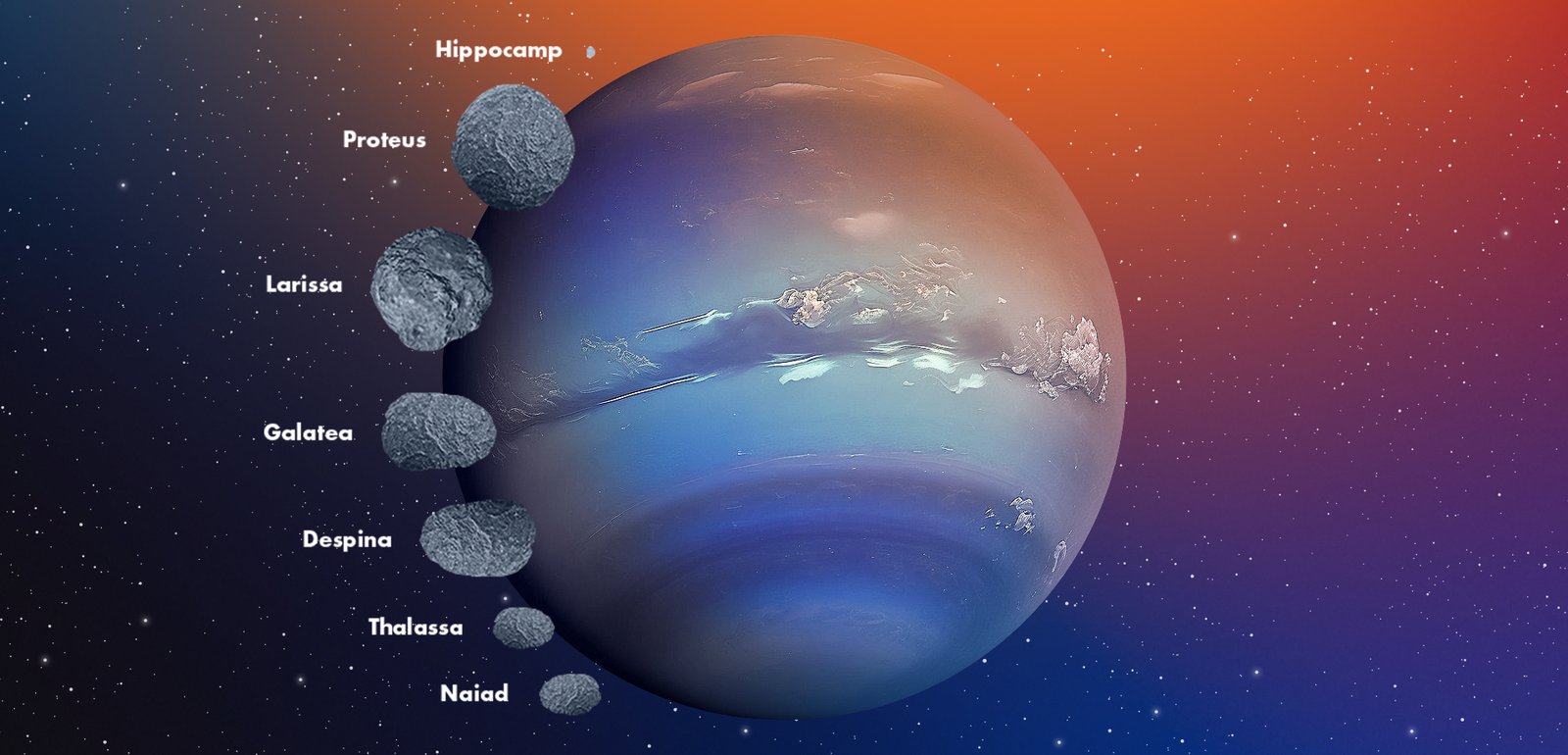Neptune’s Moons: A Detailed Examination of Triton, Nereid, and Proteus
How many Moon does Neptune have? Neptune, the eighth planet from the Sun, harbors a fascinating collection of moons, each with its own unique characteristics and mysteries. Among these, Triton, Nereid, and Proteus stand out for their distinctive features and compelling properties. Here is a closer look at these intriguing celestial bodies orbiting Neptune.
How many Moon does Neptune have? Triton, the 1st one.
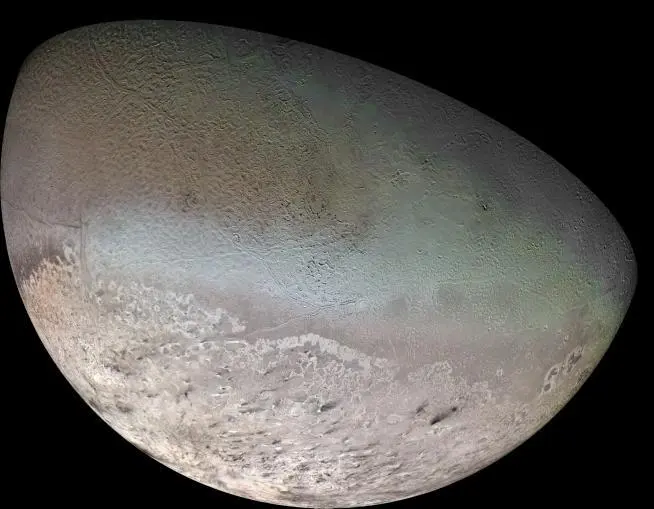
Physical Characteristics, Size, and Composition
- Triton is the largest of Neptune’s moons, with a diameter of about 2,710 kilometers. Its surface is composed largely of frozen nitrogen, with traces of water ice and frozen carbon dioxide. The moon’s icy shell covers an underlying layer of water ice, which may envelop a subsurface ocean.
- Triton has a rocky core, which is estimated to make up about two-thirds of its mass. This makes the moon one of the few in our solar system known to have a differentiated interior, with denser materials sinking towards the center and lighter materials rising towards the surface.
- The moon’s surface is marked by a diverse terrain, with smooth plains, valleys, and ridges. It also has active geysers that spew out nitrogen gas and dark particles. This activity is thought to be caused by the heating of Triton’s interior due to tidal forces from Neptune.
Orbit and Rotation
- Triton has a highly elliptical orbit around Neptune, which takes about 5 days to complete. However, unlike most moons in our solar system that orbit their parent planets in the same direction of the planet’s rotation, Triton orbits Neptune in the opposite direction. This suggests that the moon was likely captured from the Kuiper Belt, a region beyond Neptune that is home to many small icy bodies.
- The moon’s rotation is also unique, with its axis tilted at almost 90 degrees. This means that Triton experiences extreme seasons, with one pole facing towards the Sun for many years while the other remains in darkness. This may explain the presence of frozen nitrogen and other ices on its surface.
Interesting Facts
- Triton is one of only two moons in our solar system known to have a retrograde orbit (orbiting in the opposite direction of its parent planet’s rotation), the other being Saturn’s moon Phoebe.
- The moon was discovered just 17 days after Neptune itself was discovered in 1846, making it the first moon to be discovered by mathematical prediction rather than by direct observation.
- Triton is slowly moving closer to Neptune and is expected to eventually be torn apart by tidal forces and form a ring system around the planet. This fate is shared by a few other moons in our solar system, including Mars’ moon Phobos and Saturn’s moon Enceladus.
Nereid

Physical Characteristics and Composition
- Nereid is the third-largest moon of Neptune, with a diameter of about 340 kilometers. Its surface is composed largely of water ice, with smaller amounts of rock and carbon-based compounds.
- The moon has a highly irregular shape and its surface is heavily cratered, indicating that it may have been bombarded by impacts throughout its history.
Orbit and Rotation
- Nereid has a highly elliptical and slightly inclined orbit around Neptune, taking about 360 days to complete one revolution. Its distance from Neptune can vary greatly, with the closest approach being just 1.37 million kilometers and the farthest point reaching up to 9.66 million kilometers.
- The moon’s rotation is chaotic, meaning that it has no fixed axis of rotation and may tumble randomly as it orbits Neptune. This phenomenon is thought to be caused by the gravitational influence of other moons in the system.
Interesting Facts
- Nereid was discovered in 1949, over 100 years after Neptune’s discovery. It was named after a sea nymph from Greek mythology.
- The moon’s highly irregular orbit has made it difficult to study, and scientists have only been able to obtain detailed images of its surface in recent years thanks to the Voyager 2 spacecraft flyby in 1989 and the Hubble Space Telescope.
- Nereid may be a captured object from the Kuiper Belt, similar to Triton. Its irregular orbit and chaotic rotation further support this theory.
Proteus
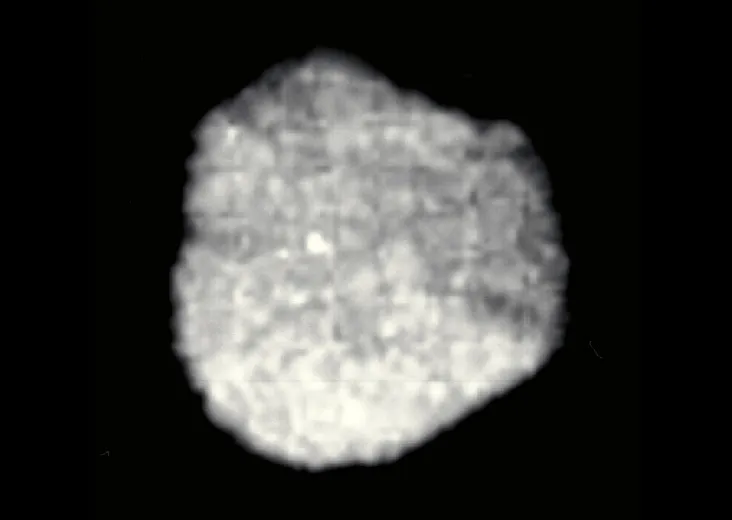
Physical Characteristics, Size, and Composition
- Proteus is the second-largest moon of Neptune, with a diameter of about 420 kilometers. It has a heavily cratered surface and is made up mainly of water ice and rock.
- The moon’s shape is almost spherical, which indicates that it may have enough self-gravity to pull itself into a round shape. However, this is not the case for all large bodies in our solar system – Pluto’s moon Charon, for example, is also spherical despite being much smaller than Proteus.
Orbit and Rotation
- Proteus has a circular orbit around Neptune, taking about 27 hours to complete one revolution. It is also the closest moon to Neptune, with an average distance of only about 117,600 kilometers.
- The moon’s rotation is synchronous, meaning that it rotates on its axis at the same rate as it orbits Neptune. This results in one side of Proteus always facing towards Neptune while the other always faces away.
Interesting Facts
- Proteus was discovered in 1989 by the Voyager 2 spacecraft and was named after a sea god from Greek mythology.
- The moon’s surface is heavily cratered, leading scientists to believe that it may be one of the oldest objects in Neptune’s system. This is supported by its high density, which suggests that it has been able to retain its original composition without significant internal heating or differentiation.
- Proteus may have been a larger object in the past that was shattered by impacts, leading to its current irregular shape and heavily cratered surface. This hypothesis is supported by images taken by Voyager 2, which show a large impact basin on one side of the moon. Further study of Proteus may provide insight into the early history of Neptune’s moon system and the processes that have shaped its moons over time. As more data is gathered from ongoing missions, we continue to learn more about these fascinating worlds in our outer solar system. From their unique features and compositions to their mysterious origins, these moons offer endless opportunities for exploration and discovery. Who knows what new information and surprises they may hold in store for us in the future? Only time, and further exploration, will tell. So let’s continue to keep our eyes on these distant moons of Neptune and see what other secrets they may reveal to us. Happy stargazing!
Neptune’s Fascinating Moon: Despina

Neptune, the eighth planet from the Sun, hosts a captivating collection of moons, each with its unique characteristics and mysteries. Among its 14 known moons, Despina stands out for its close relationship with the planet and intriguing features. Discovered by the Voyager 2 spacecraft in 1989, Despina is named after a nymph from Greek mythology who is a daughter of Poseidon, the Greek counterpart of Neptune.
Physical Characteristics, Size, and Composition
Despina is relatively small, with an estimated diameter of about 150 kilometers (93 miles), making it one of Neptune’s smaller moons. Its irregular shape and relatively smooth surface suggest a composition primarily of water ice mixed with silicate rock. Unlike Neptune’s largest moon, Triton, or even Proteus, Despina doesn’t showcase a heavily cratered surface. This could imply a younger surface age, possibly due to resurfacing events or formation from the debris of larger Neptunian moons.
Orbit and Rotation
Despina orbits Neptune at a distance of approximately 52,526 kilometers (32,644 miles) from the planet’s center, making it one of the innermost moons of Neptune. Its orbit lies within Neptune’s ring system, specifically close to the Adams Ring, and Despina plays a vital role as a shepherd moon, helping maintain the ring’s structure. Like many moons in the solar system, Despina is tidally locked with Neptune, meaning the same side of the moon always faces the planet, a characteristic that ensures one hemisphere is perpetually shielded from direct sunlight.
Interesting Facts and Observations
Despina’s proximity to Neptune offers a unique vantage point for studying the planet’s atmosphere and the intricate dynamics of its ring system. Although smaller and less studied than some of Neptune’s other moons, Despina’s role in the planetary ring system and its interactions with Neptune make it an object of significant scientific interest.
One fascinating aspect of Despina, shared with its neighboring moons Galatea and Larissa, is its influence on Neptune’s rings. These moons are crucial in maintaining the sharp edges of the rings, acting as shepherd moons, a phenomenon also observed in Saturn’s rings. This gravitational interaction highlights the complex interplay between Neptune and its moons, showcasing the dynamic and interconnected nature of celestial bodies.
Future Explorations
The brief encounter of Voyager 2 with Neptune provided invaluable data about Despina, but many questions about this small moon remain unanswered. Future missions to the Neptunian system could shed light on Despina’s origins, whether it formed alongside Neptune or is a fragment of a larger moon shattered by impacts, and how its presence alongside other moons influences the ring system.
Understanding Despina and Neptune’s other moons is not just about adding to our knowledge of the solar system’s outer reaches. It also offers insights into the processes that govern moon formation, planetary ring dynamics, and the fascinating interactions between planets and their satellites. With advancements in space exploration technology, we may soon learn more about these distant worlds, unlocking further secrets of our solar system.
As we continue to explore the cosmos, moons like Despina remind us of the beauty and complexity of the universe, urging us to look beyond our planet and appreciate the myriad wonders that lie waiting to be discovered in the vast expanse of space. Since Despina’s discovery over 30 years ago, it has continued to captivate scientists and stargazers alike, leaving us eagerly anticipating what else this intriguing moon has in store for us. So let us continue our journey of exploration and marvel at the secrets that await us in Neptune’s fascinating moon, Despina.
An In-Depth Exploration of Galatea, Neptune’s Moon
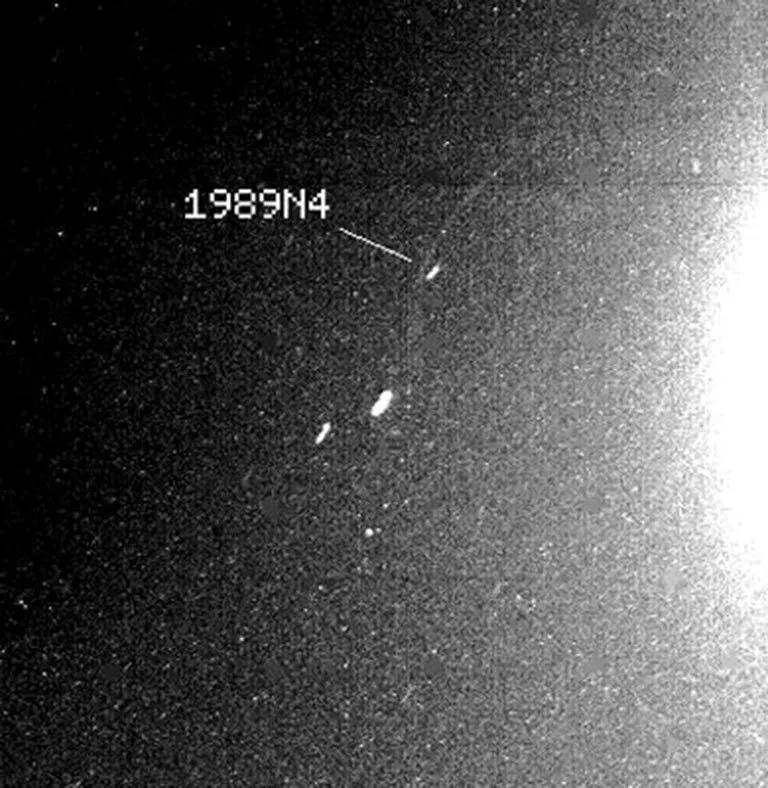
Nestled deep within the mysteries of our solar system lies Galatea, one of Neptune’s intriguing moons. Though not as widely recognized as some of its cosmic neighbors, Galatea holds unique characteristics and secrets that offer valuable insights into the celestial mechanics and history of Neptune’s moon system. Below, we explore the physical attributes, orbit, and some captivating facets of this relatively lesser-known moon.
Physical Characteristics, Size, and Composition
Galatea, with its irregular shape and relatively small size, is an intriguing celestial body orbiting Neptune. It measures approximately 176 kilometers in diameter, making it one of Neptune’s smaller moons. Despite its diminutive stature, Galatea plays a significant role in Neptune’s ring system dynamics.
The surface of Galatea is characterized by a dark, reddish color, indicative of the presence of complex organic compounds known as tholins. These compounds are believed to form through the interaction of solar ultraviolet radiation with methane, present either on the moon’s surface or in the vicinity of Neptune’s magnetosphere.
Orbit and Rotation
Galatea orbits Neptune at a distance of about 62,000 kilometers, situating it well within the planet’s magnetosphere. Its orbital period is slightly over 10 hours, which is less than half a day on Earth, reflecting a swift traversal around Neptune. One of the most fascinating aspects of Galatea’s orbit is its relationship with Neptune’s rings. Galatea acts as a shepherding moon for Neptune’s Adams ring, helping to maintain its structure and confining its particles within a narrow band through gravitational interactions.
Like many moons in the outer solar system, Galatea is tidally locked to Neptune. This means that the same side of Galatea always faces the planet, a common trait among moons that results from the gravitational forces exerted by their primary planets over time.
Interesting Facts
Galatea is not just another moon; it’s a key player in maintaining one of the solar system’s most intriguing phenomena—planetary rings. Its gravitational influence is essential for the stability of Neptune’s Adams ring, showcasing the complex interplay between celestial bodies.
Discovered in 1989 by the Voyager 2 spacecraft alongside other Neptunian moons, Galatea’s discovery marked a significant advancement in our understanding of Neptune’s moon system. This discovery was part of Voyager 2’s historic flyby of Neptune, which provided unprecedented insights into the ice giant and its satellites.
Galatea’s composition and origin continue to be subjects of research. Given its proximity to Neptune and interactions with the planet’s magnetic field, scientists believe that studying Galatea can provide deeper insights into the magnetic, atmospheric, and evolutionary dynamics of Neptune.
Galatea may be small in size, but its role in the celestial ballet of Neptune’s moons is undeniable. From shepherding rings to offering clues about the magnetic and atmospheric conditions of Neptune, Galatea presents a compelling case study in the complexity and beauty of our solar system’s outer reaches. As our exploratory missions and technological capabilities advance, we look forward to uncovering more secrets about Galatea and its fellow moons, bringing us closer to understanding the intricate dance of celestial bodies billions of kilometers away. So, there’s always more to discover and learn about this fascinating moon and its place in the vastness of our solar system. Keep exploring!
Neptune’s Moon: Halimede
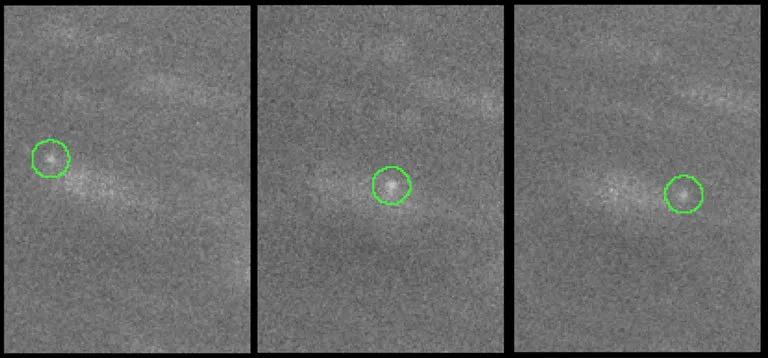
Neptune, the eighth planet from the Sun, is known for its intricate system of moons, with a total of fourteen confirmed satellites. Among these celestial bodies is Halimede, one of Neptune’s more mysterious and less studied moons. Unlike its bigger sibling Proteus, Halimede has characteristics that intrigue astronomers and astrophysicists alike.
Discovery and Naming
Halimede was discovered on August 14, 2002, by Matthew J. Holman, John J. Kavelaars, Tommy Grav, Wesley C. Fraser, and Dan Milisavljevic using the 4-meter Blanco telescope at Cerro Tololo Inter-American Observatory in Chile. This moon, along with several others discovered around the same time, marked a significant expansion in our understanding of Neptune’s outer satellite system. Halimede is named after one of the Nereids in Greek mythology. In keeping with the convention of naming Neptune’s moons after sea gods or figures associated with Poseidon (Neptune’s Greek counterpart), the name Halimede fits right in.
Physical Characteristics
Halimede stands out primarily for its highly irregular shape and relatively small size, with an estimated diameter of about 62 kilometers (38 miles). This suggests it lacks the gravitational pull to shape itself into a more spherical form, common among smaller celestial bodies. Details about its composition are not as well-known as those of larger moons, but it is likely composed of water ice mixed with a dark material, possibly organic compounds or radiation-processed ices, which gives it a reddish or gray color in telescopic images.
Orbit and Rotation
Halimede’s orbit is what truly sets it apart from most of Neptune’s other moons. It follows a highly inclined, retrograde orbit around Neptune, meaning it moves in the opposite direction to the planet’s rotation and most of its other moons. This retrograde motion is a clue that Halimede may not have formed in place around Neptune but rather could be a captured object, possibly a former member of the Kuiper Belt or another such body that was gravitationally snagged by Neptune’s influence.
Halimede’s orbit has a high eccentricity and inclination, which leads to speculation about its past interactions with other moons or even transient Kuiper Belt objects, which could account for its irregular orbit and possibly its formation and capture.
Interesting Facts
One of the more captivating aspects of Halimede is its possible connection to Neptune’s other irregular moons, Nereid and Psamathe, through their similar orbital characteristics, suggesting a shared or violent history that might include fragmentation from a larger parent body or past orbital shuffles resulting from Neptune’s migration in the early solar system.
Halimede, along with Neptune’s other outer irregular moons, opens a new window into the past dynamics of the outer solar system. Their study provides insights into the processes of moon capture, the influence of giant planets on the distribution of smaller bodies in the early solar system, and the complex gravitational interactions that can lead to such unconventional orbits.
The Future of Exploration
Currently, detailed investigation of Halimede is limited by its small size and distant orbit, making it a challenging target for observation even with powerful telescopes. However, future missions to the outer solar system or advancements in telescope technology may allow scientists to gain more detailed insights into Halimede’s composition, origin, and history.
Halimede remains a testament to the diverse and intriguing nature of Neptune’s moons. Its unusual orbit, potential for a fascinating capture history, and implications for the broader dynamics of the outer solar system make it an intriguing subject for continued research and observation. As humanity’s understanding of these distant objects grows, so too does our appreciation for the complexity and beauty of the cosmos. While we may never fully unravel the mysteries of Halimede and its fellow moons, they will continue to inspire and intrigue us for generations to come. So let us continue to explore, discover, and marvel at the wonders of our universe.
Exploring Neptune’s Icy Companion: Hippocamp

Nestled amongst Neptune’s collection of moons, Hippocamp stands out not just for its name, derived from the mythological sea creature, but also for its intriguing characteristics. This celestial body, though small in the grandeur of our solar system, offers a fascinating glimpse into the complex orbital dynamics and geological history of Neptune’s satellites.
Discovery and Naming
Hippocamp, Neptune’s moon, was discovered relatively recently in 2013, using the Hubble Space Telescope. Its naming follows the tradition of selecting names from ancient mythology, with “Hippocamp” referencing a creature that is half horse, half fish from Greek legends.
Physical Characteristics
With a diameter of approximately 34 kilometers, Hippocamp is one of the smaller satellites orbiting Neptune. Despite its modest size, it plays a significant role in the intricate dance of Neptune’s moons. The moon’s surface is believed to be composed predominantly of water ice, intermingled with silicate rock, a common composition for objects in the outer solar system.
Orbit and Interaction
Hippocamp orbits Neptune at a distance of about 105,000 kilometers, positioning it close to Proteus, Neptune’s second-largest moon. What’s remarkable about Hippocamp is its orbital relationship with Proteus. Some scientists posit that Hippocamp may have originated from debris resulting from a comet impact on Proteus. This theory is supported by the fact that Hippocamp’s orbit is closely tied to that of Proteus, suggesting a shared history.
Scientific Significance
The study of Hippocamp offers valuable insights into the dynamic processes governing Neptune’s moon system. Its close proximity to Proteus and seeming interconnected orbital dynamics highlight the complexity of satellite interactions in the outer solar system. Researchers are particularly interested in understanding how collisions and debris re-accumulation contribute to the formation and evolution of moons around gas giants like Neptune.
Future Exploration
As of now, our knowledge about Hippocamp has been limited to observations made by the Hubble Space Telescope and theoretical modeling. Future missions to the outer solar system may provide an opportunity to study this moon up close, offering clarity on its origin, composition, and the role it plays in Neptune’s celestial family.
In the grand tapestry of our solar system, moons like Hippocamp remind us of the constant evolution and dynamic changes occurring over astronomical timescales. They serve as a testament to the past events, such as collisions and re-accretions, that have shaped the current configuration of planetary systems.
Hippocamp may be small, but its discovery and subsequent study contribute significantly to our understanding of the Neptune system and, by extension, the broader mechanisms at play in the formation and evolution of celestial bodies in our solar system. As we continue to extend our gaze into the cosmos, moons like Hippocamp offer endless opportunities for discovery, challenging our assumptions and enriching our knowledge of the universe. So, it is crucial to continue exploring and learning about these enigmatic icy companions, unlocking the secrets of our solar system one moon at a time.
We may never fully understand all there is to know about Hippocamp, but its mysteries will continue to inspire us to push the boundaries of human knowledge and curiosity. The exploration of this tiny but mighty moon will undoubtedly continue to captivate our imaginations and expand our understanding of the vast expanse that is our universe. So let us continue to marvel at its beauty, ponder its mysteries, and endeavor to unravel its secrets for generations to come.
The journey may be long, but with each discovery, we get one step closer to unlocking the secrets of Neptune’s icy companion: Hippocamp. As we continue to explore and uncover the secrets of our universe, let us never forget the importance of these small yet significant celestial bodies that continue to amaze and fascinate us.
Laomedeia: Neptune’s Enigmatic Moon

Neptune, the eighth planet from the Sun, is a world of intrigue and mystery, surrounded by a family of moons that embody the extremities and wonders of the outer solar system. Among these celestial bodies orbits Laomedeia, one of Neptune’s lesser-known but equally fascinating moons.
Physical Characteristics, Size, and Composition
Laomedeia remains one of the more enigmatic members of Neptune’s lunar family, primarily due to its distance and relatively small size. Precise details about its physical characteristics and composition are challenging to ascertain without closer observation, which has yet to be achieved as of current space exploration missions. However, based on observations from Earth and data gathered by passing spacecraft like Voyager 2, we can infer that, like many of Neptune’s moons, Laomedeia is likely composed of a mixture of water ice and rock.
The size of Laomedeia poses an interesting discussion point. Being one of Neptune’s outer moons, it is significantly smaller than Proteus, Neptune’s second-largest moon, with a diameter of about 420 kilometers. The intricate surface features, composition, and exact dimensions of Laomedeia remain subjects for future study as space exploration technology advances and as missions to the outer planets become more feasible.
Orbit and Rotation
Laomedeia orbits Neptune at a considerable distance, making it part of the outer group of Neptunian moons. These outer moons have more eccentric orbits compared to the closer, inner moons like Proteus, which follows a nearly perfect circular trajectory around Neptune. The exact details of Laomedeia’s orbit, including its orbital period and whether it exhibits synchronous rotation (always showing the same face to Neptune), are areas ripe for research as they can reveal much about the moon’s history and interaction with Neptune’s gravitational field.
Discovery and Exploration
The discovery of Laomedeia was not through direct observation but inferred through sophisticated telescopic technologies and deep space explorations that have helped astronomers piece together Neptune’s extensive lunar system. Each discovery adds a new layer to our understanding of the Neptunian system and provides further evidence of the dynamic processes that govern the outer solar system.
Interesting Facts
Laomedeia, along with Neptune’s other moons, shares a mythological naming convention, drawing from the pantheon of Greek and Roman deities associated with the sea. This naming tradition reflects the mysterious and fluid nature of our knowledge regarding these distant worlds, which, much like the mythological seas, are vast and filled with unknowns.
The Future of Exploration
The intrigue surrounding Laomedeia and its neighboring moons calls for future exploratory missions that could unveil their secrets. With advances in aerospace technology, such as the development of more powerful telescopes and unmanned space probes, our understanding of Laomedeia will undoubtedly grow. These missions could offer insights not only into the moon itself but also into the formation and evolution of Neptune’s lunar system, and by extension, the dynamics of the outer solar system.
Laomedeia is a testament to the boundless curiosity that drives humanity to explore the cosmos. Though details about this distant moon are currently scarce, its presence challenges us to push further into the unknown. The pursuit of knowledge about Laomedeia and moons like it underscores the importance of space exploration and its ability to enlighten us about the universe’s vast, uncharted frontiers.
As we plan future expeditions and develop new technologies, moons such as Laomedeia stand as beacons in the dark, guiding us on our cosmic odyssey. So, let us continue to unravel the mysteries of Laomedeia and the outer solar system, one discovery at a time.
Exploring Neptune’s Moons: A Deep Dive into Larissa
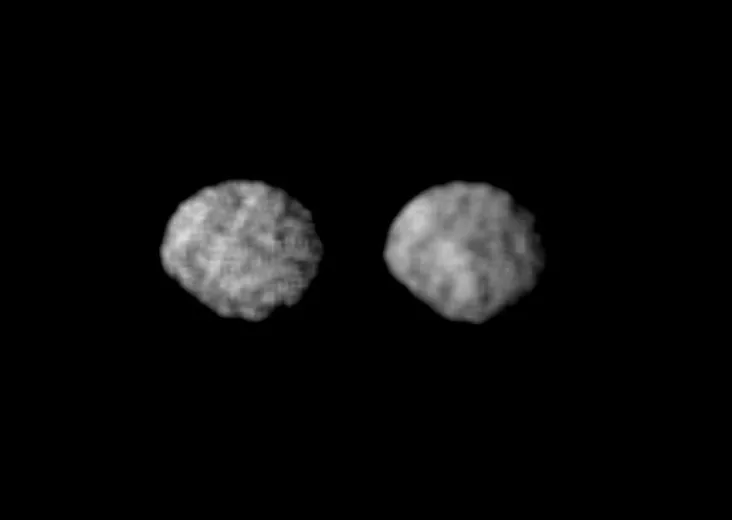
Neptune, the eighth and farthest known planet from the Sun in our solar system, is known for its impressive ring system and fascinating collection of moons. Among these celestial bodies, one moon emerges from the shadows to claim its unique position in Neptune’s orbit—Larissa.
Physical Characteristics, Size, and Composition
Larissa presents an intriguing case of celestial mechanics and geology. It is relatively small in size, with an irregular shape measuring about 194 kilometers (120 miles) in its largest dimension. This size classification places Larissa in the category of Neptune’s inner moons, among which it holds a remarkable spot due to its peculiar characteristics.
Composed primarily of water ice and rock, Larissa’s surface is testament to the turbulent history it has endured. Its pockmarked landscape is filled with craters and grooves, indicating significant geological activity in the past. These features suggest that Larissa, much like other celestial bodies in Neptune’s orbit, has been shaped by episodes of collisions and impacts.
Orbit and Rotation
Larissa orbits Neptune at a distance of approximately 73,548 kilometers (45,703 miles), making it one of Neptune’s closer moons, nestled well within the planet’s magnetosphere. This proximity has implications for Larissa’s orbital dynamics and the gravitational interactions it experiences.
This moon completes one full orbit around Neptune in about 0.555 Earth days (approximately 13.32 hours), showcasing a rapid traversal of its host planet’s immense gravitational field. Notably, Larissa is locked in a synchronous rotation with Neptune. This tidal locking ensures that one face of Larissa is perpetually turned towards the planet, offering the same view to Neptune over each orbit.
Interesting Facts and Discoveries
Larissa was not discovered from Earth-based observations but rather during one of space exploration’s landmark missions. The Voyager 2 spacecraft, during its flyby of Neptune in 1989, was responsible for the discovery of Larissa along with several other Neptunian moons. This was a pivotal moment in our understanding of Neptune and its natural satellites, propelling Larissa from obscurity into the realm of studied celestial bodies.
Subsequent observations and analyses post-Voyager 2 have hinted at Larissa’s complex past. Its heavily cratered and grooved surface records a history of cosmic ballet, where celestial objects have danced too close, leaving marks of their encounters. Scientists believe these features could be key to unlocking the secrets of Neptune’s moon system’s formation and evolutionary history.
One of the most captivating aspects of studying Larissa and other Neptunian moons lies in their potential to inform us about the conditions and processes at play in the outer solar system. By comparing these moons’ geological features and orbital behaviors to those of other celestial bodies, researchers can gain insights into the broader narrative of our solar system’s formation and the dynamics that govern it.
Future Prospects
The exploration of Larissa and Neptune’s other moons is far from complete. Each new observation and piece of data collected has the potential to reshape our understanding of these distant worlds. Proposed future missions to the Neptunian system could provide more detailed analyses of Larissa’s surface composition, geology, and the effects of Neptune’s magnetosphere on its moon.
The study of Larissa offers a window into the past, present, and future of the solar system’s outer reaches. It challenges us to think beyond our Earth-centric perspective, inviting us to consider the complex and dynamic nature of the universe. As we continue to explore the cosmos, moons like Larissa serve as reminders of the mysteries that lie waiting in the dark, ready to unfold their secrets to the curious eyes of humanity.
Overall, the study of Larissa and Neptune’s moons is a testament to our innate curiosity and drive to understand the world around us. With each new discovery, we come closer to unraveling the enigmas that surround us in the vast expanse of space. So let us continue to explore and delve deeper into Neptune’s moon system, where wonders like Larissa await.
Naiad: Neptune’s Innermost Moon
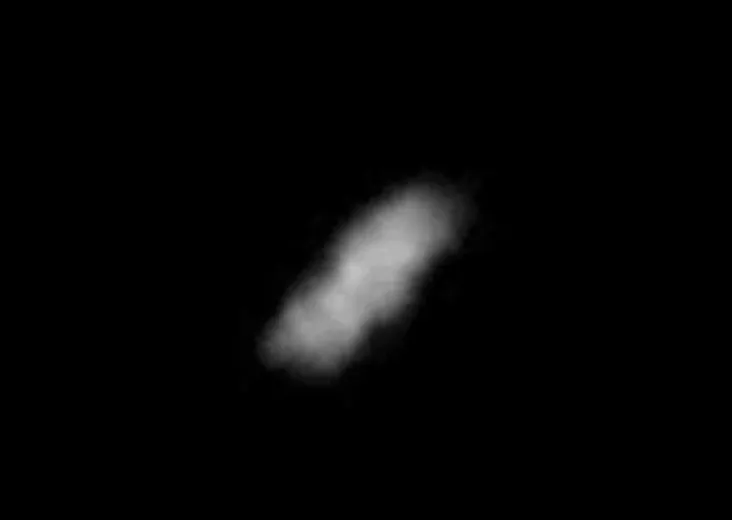
Neptune, the eighth planet from the Sun, hosts a fascinating assembly of moons, each with its unique characteristics and mysteries. Among these celestial bodies, Naiad stands out as Neptune’s innermost moon, offering intriguing insights into the Neptune moon system’s dynamics and history. Discovered in 1989 by the Voyager 2 spacecraft, Naiad has captured the interest of astronomers and space enthusiasts alike. Here’s a detailed look at this enigmatic moon.
Physical Characteristics, Size, and Composition
Naiad is one of the smaller moons of Neptune, with an estimated diameter of approximately 66 kilometers (41 miles). Despite its modest size, Naiad plays a significant role in Neptune’s celestial family. It is primarily composed of water ice mixed with a silicate rock component. This composition is typical of many of the outer solar system’s moons, suggesting a common formation mechanism or source material.
The moon’s shape is irregular, which is characteristic of smaller celestial bodies that lack the gravitational strength to pull themselves into a more spherical shape. This irregularity in shape, coupled with its size, provides clues about the moon’s formation and the gravitational forces at play within the Neptunian system.
Orbit and Rotation
Naiad orbits closely to Neptune, at a distance of about 48,000 kilometers (30,000 miles) from the planet’s center. This proximity places it well within Neptune’s gravitational influence, resulting in a rapid orbital period of approximately 7 hours. Naiad’s orbit is fascinating because it demonstrates the complex gravitational interactions between Neptune and its moons, especially given Naiad’s close orbit in relation to the planet.
Like many moons in our solar system, Naiad’s rotation period is synchronous with its orbit around Neptune, meaning it always shows the same face to the planet. This phenomenon, known as tidal locking, is common among satellites orbiting their parent planets closely.
Interesting Facts
One of the most interesting aspects of Naiad is its relationship with other moons of Neptune, particularly Thalassa, another small moon. Naiad and Thalassa are locked in what is known as a “dance of avoidance.” Despite their close orbits, they never collide due to their perfectly timed orbital paths, which keep them at a safe distance from one another. This intricate dance underscores the complexity and beauty of celestial mechanics.
Naiad’s discovery alongside Neptune’s other inner moons in 1989 by Voyager 2 marked a significant milestone in our understanding of the Neptunian system. Its existence and characteristics have prompted further questions about the formation and evolution of Neptune’s moons and their interactions with the planet’s rings and other moons.
The Continuing Mystery
Despite the valuable information collected by Voyager 2, many aspects of Naiad remain a mystery. Its small size and proximity to Neptune make detailed observation challenging with current technology. However, ongoing advancements in telescopic and space exploration technologies promise to unlock further secrets held by Naiad and Neptune’s other moons.
Studying Naiad and its fellow moons not only enriches our knowledge of the Neptune system but also contributes to our broader understanding of planetary sciences and the dynamics of celestial bodies throughout our solar system and beyond. The future of space exploration holds the promise of new discoveries and insights into these distant worlds, continuing to fuel our curiosity and drive for exploration. So, let us keep our eyes to the sky and continue to unravel the mysteries of Naiad and other moons in the vast expanse of our solar system. There is so much more waiting to be discovered and explored!
Naiad may be small, but it holds a significant place in Neptune’s vast moon family. Its unique characteristics and complex relationship with other moons and the planet itself make it a fascinating subject of study for astronomers and space enthusiasts. As we continue to delve deeper into the mysteries of Naiad and other outer solar system worlds, we are unlocking new knowledge and understanding of our universe’s inner workings.
With each new discovery, our sense of wonder and curiosity only grows, reminding us of the endless possibilities and wonders of our universe. Let us continue to explore, discover, and learn more about Naiad and the many other celestial bodies that make up our beautiful solar system. The journey has only just begun!
Neso: Neptune’s Outermost Moon

Neso holds the distinction of being Neptune’s outermost moon, orbiting at an astonishing distance. It is one of the irregular moons of Neptune, distinguished by its highly eccentric and distant orbit.
Physical Characteristics, Size, and Composition
Neso measures roughly 60 kilometers in diameter, making it one of the smaller moons of Neptune. Due to its limited size and the vast distance from Earth, detailed observations of Neso’s surface and composition are challenging. However, it is believed to be primarily composed of water ice mixed with rock, a common trait among Neptune’s moons and other icy bodies in the outer solar system.
Orbit and Rotation
What sets Neso apart from many other moons is its incredibly distant and eccentric orbit around Neptune. It has an orbital distance of about 48 million kilometers (30 million miles) from the planet, which places it far beyond the orbits of Neptune’s other moons. Neso takes approximately 26 Earth years to complete one orbit around Neptune, showcasing the vastness of Neptune’s gravitational influence.
Neso’s orbit is also highly inclined relative to Neptune’s equator, with an inclination of about 136 degrees. This unusual orbit suggests that Neso, like other irregular moons, may have been captured into Neptune’s orbit rather than having formed in situ. The mechanisms and timing of such a capture event, as well as Neso’s origin before capture, remain subjects of research and debate among astronomers.
Interesting Facts
- Neso’s name comes from Greek mythology, where Neso is one of the Nereids, or sea nymphs, daughters of the sea god Nereus.
- It shares its irregular, distant orbital characteristics with Psamathe, another of Neptune’s outer moons, suggesting a possible commonality in their origins or capture into Neptune’s gravitational sphere.
- The extreme distance of Neso’s orbit makes it the moon with the greatest orbital distance around any of the major planets in our solar system.
Although not as extensively studied as some of Neptune’s other moons, especially given its small size and the technical challenges associated with observing such a distant object, Neso presents an interesting case study in the dynamics of outer solar system bodies. Its peculiar orbit offers valuable insights into the mechanisms of moon capture and the evolution of Neptune’s satellite system. Future observations and missions to the outer solar system may reveal more about Neso and its place in the intricate tapestry of our solar system’s moons. So, Neptune’s moons continue to fascinate and surprise us with their unique features, making them invaluable in our quest to understand the mysteries of the outer solar system.
Unveiling the Mysteries of Psamathe, Neptune’s Enigmatic Moon

In the distant reaches of our solar system, Neptune, the eighth planet from the Sun, harbors a collection of moons that intrigue astronomers and space enthusiasts alike. Among these celestial bodies, Psamathe stands out as a testament to the vastness and mystery of the cosmos. This detailed exploration of Psamathe reveals its physical characteristics, its peculiar orbit, and intriguing facts that make it a fascinating subject of study in the realm of planetary science.
Physical Characteristics, Size, and Composition
Psamathe, one of Neptune’s outermost moons, is a small and elusive world. Measuring a mere 40 kilometers in diameter, it is among the tiniest satellites orbiting Neptune. Despite its diminutive stature, Psamathe holds significant interest for researchers due to its composition and the insights it provides into the Neptunian moon system.
Composed primarily of water ice mixed with a dark material, Psamathe’s surface is reflective of its formation in the cold, outer regions of the Neptune system. Its low density suggests a porous structure, possibly resulting from a history of collisions and accretion over billions of years. The moon’s greyish coloration points to the presence of complex organic compounds, remnants of the primordial solar nebula from which the solar system formed.
Orbit and Rotation
Psamathe’s orbit around Neptune is nothing short of extraordinary. With a vastly elongated trajectory, it is categorized as one of Neptune’s irregular moons, captured by the giant planet’s gravitational influence early in the solar system’s history. Psamathe orbits at an astounding distance of approximately 46 million kilometers from Neptune, completing a single revolution around the planet in nearly 25 Earth years.
The moon’s rotation period remains a subject of speculation among astronomers. However, like many of Neptune’s moons, it is believed that Psamathe’s rotation is synchronous, keeping the same face perpetually turned toward the planet it orbits. This synchronous rotation is a common trait among moons in the solar system, resulting from tidal interactions with their host planets over aeons.
Intriguing Facts
Discovered relatively recently, in 2003, by Scott S. Sheppard, David C. Jewitt, and Jan Kleyna using advanced ground-based telescopes, Psamathe was named after a nymph from Greek mythology, reflecting the tradition of naming Neptune’s moons after mythological figures associated with the sea. The discovery of Psamathe, along with other distant Neptunian moons, has expanded our understanding of the diversity and complexity of Neptune’s moon system.
One of the most striking features of Psamathe is its incredible orbital distance, making it one of the most distant known moons of any planet in our solar system. This extreme distance challenges our understanding of gravitational capture and moon formation theories, offering a unique case study for astronomers.
Despite its remote orbit, Psamathe is bound to Neptune by the planet’s gravitational pull, resisting the call of the open cosmos. Its existence raises questions about the early solar system and the mechanisms by which planets acquire their retinues of moons. Studying Psamathe and its kin can provide valuable clues about planetary formation and the evolution of moon systems around gas giants.
The Future of Exploration
As we continue to explore the outer reaches of our solar system, moons like Psamathe remind us of the countless mysteries awaiting discovery. Each piece of data we gather brings us one step closer to understanding the complex tapestry of our cosmic neighborhood. Although robotic missions to Neptune and its moons may be years away, the study of these distant worlds from Earth provides crucial insights into the nature of the universe.
In the grand scheme of space exploration, Psamathe is a reminder of the scale and wonder of our solar system. Its existence challenges us to keep looking outward, to continue probing the unknown, and to maintain our sense of curiosity about the universe we inhabit. Even as we uncover more secrets about Psamathe and other celestial bodies, there will always be new mysteries to unravel, urging us to keep reaching for the stars.
So let’s keep our eyes fixed on the distant moons of Neptune, waiting patiently for them to reveal their hidden secrets and add more pieces to the grand puzzle of our solar system. As technology advances and our understanding grows, we can only imagine the wonders that await us in the vast expanse of space. So let us continue to explore, to discover, and to be awed by the mysteries of Psamathe and beyond.
Unveiling the Mysteries of Sao, Neptune’s Enigmatic Moon
In the outermost reaches of our solar system, orbiting the ice giant Neptune, lies a small moon named Sao. This celestial body, one of Neptune’s numerous moons, intrigues astronomers and space enthusiasts alike with its unique characteristics and elusive nature.
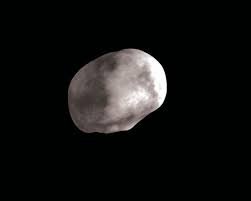
Discovery and Naming
Sao was discovered in late 2002, expanding our understanding of Neptune’s intricate moon system. Named after a deity in Greek mythology associated with the sea, Sao carries on the tradition of naming Neptune’s moons after lesser-known sea gods and nymphs. The discovery of Sao, along with several other Neptunian moons in the early 2000s, marked a significant advancement in our telescopic capabilities and understanding of distant celestial objects.
Physical Characteristics
Sao is a small, irregularly shaped moon, much like the other outer moons of Neptune. Its exact dimensions are challenging to pinpoint due to its distant orbit and relatively small size compared to Neptune’s larger moons like Triton and Proteus. Sao’s surface is believed to be composed primarily of water ice, mixed with silicate rock and possibly methane ice, which is common among the outer solar system’s icy bodies.
Orbit and Rotation
Sao orbits Neptune at a significant distance, classified as one of Neptune’s outer irregular moons. Its orbit is prograde, meaning it moves in the same direction as Neptune’s rotation, but with a high inclination and eccentricity, suggesting that it may have been captured into Neptune’s orbit rather than forming in-situ. The irregular nature of Sao’s orbit implies a potentially chaotic past, possibly involving gravitational interactions with Neptune’s other moons or passing celestial bodies, which could have altered its trajectory into the peculiar orbit we observe today.
Scientific Significance
While Sao may not boast the size or dramatic features of some of the solar system’s more famous moons, its existence offers valuable clues into the history and evolution of Neptune’s moon system. Studying Sao and its counterparts can help scientists understand the processes of moon capture, the dynamics of distant orbital systems, and the composition of celestial bodies in the Kuiper Belt, where Neptune resides.
Future Exploration
The remote location and relatively small size of Sao present challenges for detailed exploration. However, as our technological capabilities progress, future missions to the outer solar system may yield more in-depth data on Sao and its fellow Neptunian moons. Spacecraft equipped with advanced imaging and spectrometric instruments could provide clearer insights into Sao’s composition, origin, and the role it plays in Neptune’s celestial family.
For now, Sao remains a distant, mysterious object, silently orbiting Neptune in the dark, cold reaches of space. Yet it stands as a testament to the vast diversity and complexity of our solar system’s outer realms, reminding us that there is still much to discover beyond the planets and moons closer to home. As we continue to look outward, moons like Sao beckon with the promise of new knowledge and the potential to unravel some of the cosmos’s most enduring mysteries.
Neptune’s Moons: A Focus on Thalassa

Neptune, the eighth and farthest known planet from the Sun, harbors a system of 14 confirmed moons. Each of these celestial bodies offers a unique insight into the outer reaches of our solar system. Among them, Thalassa, a small yet intriguing moon, captures the curiosity of astronomers and space enthusiasts alike.
Physical Characteristics, Size, and Composition
Thalassa, named after the sea goddess from Greek mythology, is one of Neptune’s innermost moons. It is relatively small, with an estimated diameter of about 82 kilometers. Despite its diminutive size, Thalassa plays a significant role in Neptune’s gravitational ballet.
The moon’s surface is thought to be composed primarily of water ice mixed with silicate rock. This composition is typical for moons in the outer solar system, where temperatures are too cold for rock alone to make up the bulk of a celestial body.
Orbit and Rotation
Thalassa orbits Neptune at a distance of approximately 50,000 kilometers, making it one of the planet’s closest satellites. Its orbit is nearly circular and lies inside Neptune’s faint rings, providing a unique vantage point for studying the planet’s atmosphere and ring system.
Like many moons in the outer solar system, Thalassa is tidally locked with Neptune. This means that the same side of Thalassa always faces the planet, a characteristic indicating a synchronous rotation period with its orbital period around Neptune.
Interesting Facts
Thalassa’s proximity to Neptune and its interactions with the planet’s rings and other moons present a fascinating case study for astronomers. It is part of a group of moons that are in closely spaced orbits, leading to interesting gravitational interactions.
One notable aspect of Thalassa’s orbit is its relationship with Naiad, another of Neptune’s moons. The two moons are in a stable orbital resonance. This means that for every one orbit Thalassa completes around Neptune, Naiad completes four, preventing them from coming too close and potentially destabilizing each other’s orbits.
Thalassa was discovered in 1989 by the Voyager 2 spacecraft during its flyby of Neptune. The discovery marked a significant milestone in our understanding of Neptune’s moon system, highlighting the diversity and dynamism of the moons orbiting the outer planets.
Despite its small size, Thalassa’s proximity to Neptune, interaction with the planet’s rings, and its dance with other moons provide invaluable data about the gravitational complexities and dynamics within Neptune’s moon system. Thalassa’s study continues to shed light on the intricate and often surprising nature of the solar system’s outer reaches.
In conclusion, Thalassa may be a small component of Neptune’s moon system, but it stands as a testament to the intricate and interconnected nature of celestial bodies. Its role in Neptune’s gravitational harmony exemplifies the delicate balances that govern the motions of moons and planets alike. As we continue to explore the outer solar system, moons like Thalassa remind us of the wonders that wait to be discovered in the vastness of space. So, Thalassa – a small but mighty moon worthy of our fascination and admiration.
Future Explorations
As technology advances and space exploration continues to progress, there is no doubt that we will learn even more about Thalassa and the other moons of Neptune. With future missions planned for the outer solar system, including potential visits to Neptune and its moons, we can look forward to further unraveling the mysteries of these distant worlds.
One exciting prospect is the potential for a dedicated mission to Thalassa. A spacecraft designed specifically to study this small moon could provide unprecedented details about its surface, composition, and interactions with Neptune. Such a mission could also shed light on other aspects of Neptune’s moon system and deepen our understanding of this intriguing planet.
As we continue to push the boundaries of space exploration, Thalassa and its fellow moons will undoubtedly remain a focal point for scientific study and wonder. The more we learn about these distant worlds, the more we come to appreciate their beauty and complexity. So, let us keep our eyes on the skies and eagerly await what future explorations may reveal about Thalassa and the secrets it holds.
So, Thalassa – a small yet mighty moon that continues to captivate our imaginations and push the boundaries of our understanding of the outer solar system. So, let’s continue to explore and discover all that this remarkable moon has to offer.
Neptune’s moons, especially Triton, Nereid, and Proteus, offer a fascinating glimpse into the dynamic and varied nature of celestial objects in our outer Solar System. Each moon’s unique characteristics – from Triton’s cryovolcanic activity and retrograde orbit to Nereid’s eccentric path and Proteus’s cratered landscape – contribute significantly to our understanding of planetary moons and their complex interactions with their host planets.

